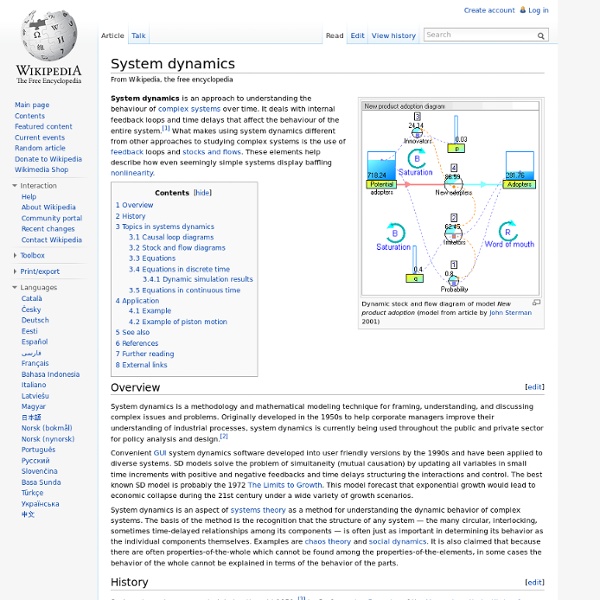Complex system
This article largely discusses complex systems as a subject of mathematics and the attempts to emulate physical complex systems with emergent properties. For other scientific and professional disciplines addressing complexity in their fields see the complex systems article and references. A complex system is a damped, driven system (for example, a harmonic oscillator) whose total energy exceeds the threshold for it to perform according to classical mechanics but does not reach the threshold for the system to exhibit properties according to chaos theory. History[edit]
RelFinder - Visual Data Web
Are you interested in how things are related with each other? The RelFinder helps to get an overview: It extracts and visualizes relationships between given objects in RDF data and makes these relationships interactively explorable. Highlighting and filtering features support visual analysis both on a global and detailed level. The RelFinder is based on the open source framework Adobe Flex, easy-to-use and works with any RDF dataset that provides standardized SPARQL access. Check out the following links for some examples: The RelFinder can easily be configured to work with different RDF datasets.
Systems thinking
For some, systems thinking is the cognitive process of studying and understanding systems of every kind. For others, the focus is on social organizations in particular.[citation needed] A system may be defined in general as a set of interrelated or interacting elements. This definition accommodates both passive structures (e.g. a necklace, or the Dewey Decimal System) and active structures.
Systems thinking
Impression of systems thinking about society[1] A system is composed of interrelated parts or components (structures) that cooperate in processes (behavior). Natural systems include biological entities, ocean currents, the climate, the solar system and ecosystems. Designed systems include airplanes, software systems, technologies and machines of all kinds, government agencies and business systems. Systems Thinking has at least some roots in the General System Theory that was advanced by Ludwig von Bertalanffy in the 1940s and furthered by Ross Ashby in the 1950s. The term Systems Thinking is sometimes used as a broad catch-all heading for the process of understanding how systems behave, interact with their environment and influence each other.
Complexity Rising: From Human Beings to Human Civilization, a Complexity Profile
Since time immemorial humans have complained that life is becoming more complex, but it is only now that we have a hope to analyze formally and verify this lament. This article analyzes the human social environment using the "complexity profile," a mathematical tool for characterizing the collective behavior of a system. The analysis is used to justify the qualitative observation that complexity of existence has increased and is increasing. The increase in complexity is directly related to sweeping changes in the structure and dynamics of human civilization—the increasing interdependence of the global economic and social system and the instabilities of dictatorships, communism and corporate hierarchies. Our complex social environment is consistent with identifying global human civilization as an organism capable of complex behavior that protects its components (us) and which should be capable of responding effectively to complex environmental demands.
Systems science
Impression of systems thinking about society. Systems science is an interdisciplinary field that studies the nature of complex systems in nature, society, and science itself. It aims to develop interdisciplinary foundations that are applicable in a variety of areas, such as engineering, biology, medicine, and social sciences.[1]
The transition from Search to Social Media: The future of information networks
The king of Web corporations has been Google with its dominance of search. Recently, Facebook has become the second-most popular website. How do the purposes of each of these successful sites differ, and where do they compete?
Autopoiesis
3D representation of a living cell during the process of mitosis, example of an autopoietic system. The original definition can be found in Autopoiesis and Cognition: the Realization of the Living (1st edition 1973, 2nd 1980): Page 78: - An autopoietic machine is a machine organized (defined as a unity) as a network of processes of production (transformation and destruction) of components which: (i) through their interactions and transformations continuously regenerate and realize the network of processes (relations) that produced them; and (ii) constitute it (the machine) as a concrete unity in space in which they (the components) exist by specifying the topological domain of its realization as such a network. [1] Page 89:- [...] the space defined by an autopoietic system is self-contained and cannot be described by using dimensions that define another space.



